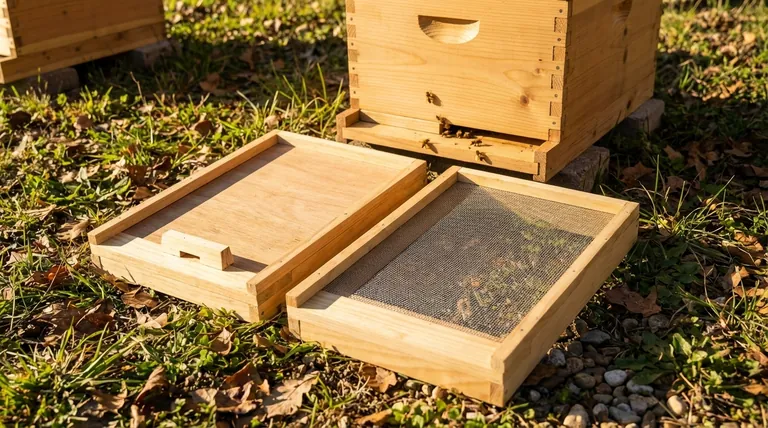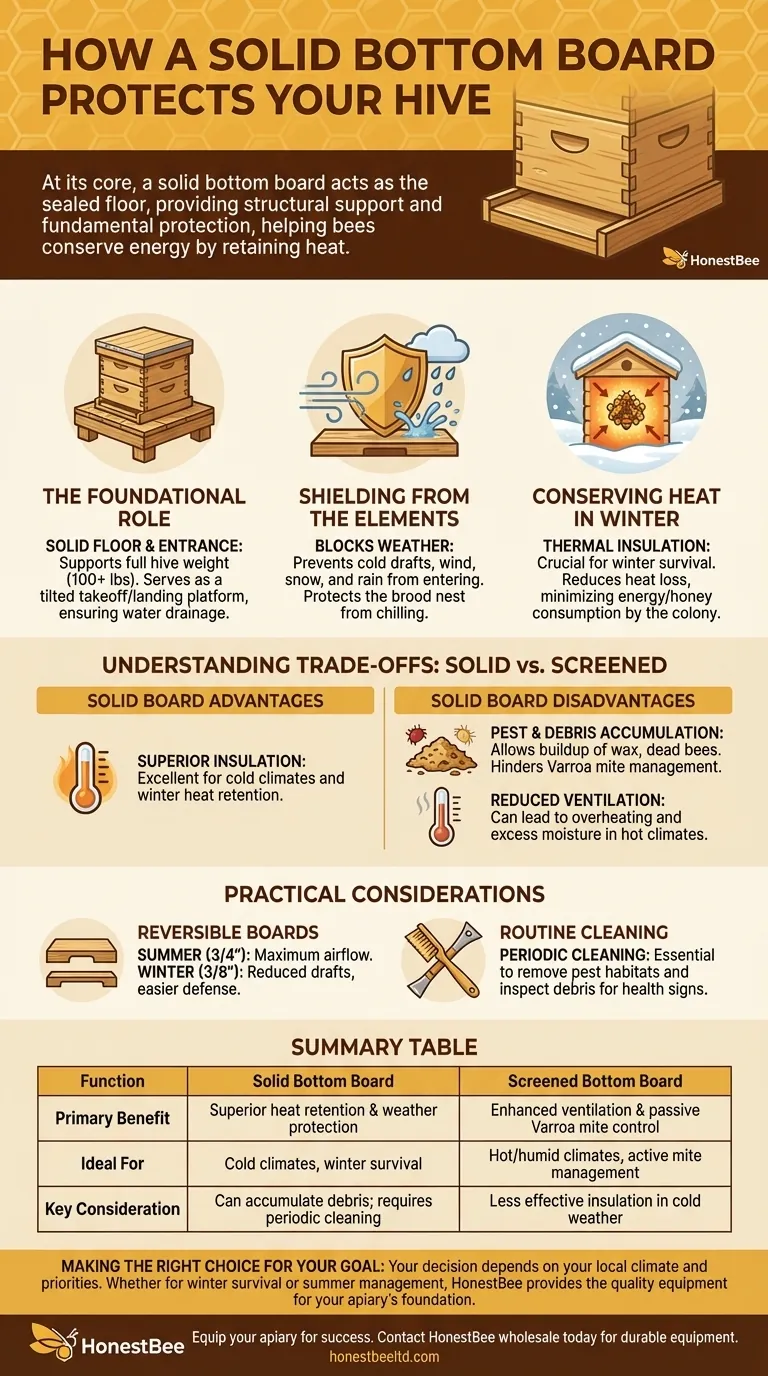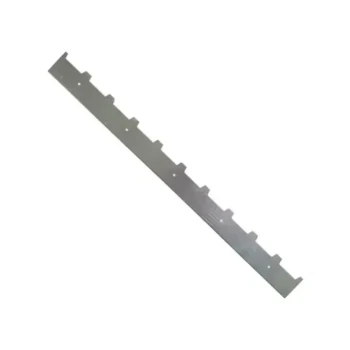At its core, a solid bottom board acts as the sealed floor of the beehive, providing essential structural support and fundamental protection from the outside world. Its primary function is to shield the colony from the elements—especially ground-level drafts and moisture—and to help the bees conserve precious energy by retaining heat within the hive.
The choice of a bottom board is a foundational decision in beekeeping. It forces a direct trade-off between the superior thermal insulation offered by a solid board and the enhanced ventilation and pest management capabilities of a screened board.

The Foundational Role of the Solid Bottom Board
A solid bottom board is more than just a floor; it's an integral part of the hive's environmental control system. It serves several distinct, critical functions for the health and security of the colony.
Providing a Solid Floor and Entrance
The bottom board is the base upon which the entire hive—brood boxes, supers, and all—rests. It must bear the full weight of the colony, which can exceed 100 pounds (45 kg) or more.
It also creates the hive entrance and serves as the takeoff and landing platform for all foraging bees. For this reason, it must be installed with a slight forward tilt to ensure rainwater drains out and away from the hive entrance.
Shielding from the Elements
A solid, sealed floor is the hive's first line of defense against adverse weather. It completely blocks wind, snow, and splashing rain from entering the hive from below.
This protection is especially critical in preventing cold drafts from chilling the brood nest, which the bees must keep at a constant, warm temperature.
Conserving Heat in Winter
The most significant benefit of a solid bottom board is thermal insulation. In colder climates, bees form a tight cluster to generate and share warmth, and a solid floor helps contain this heat.
By reducing heat loss through the bottom of the hive, the board minimizes the amount of energy (and honey) the bees must consume to survive the winter. This can be a decisive factor in the colony's ability to make it through to spring.
Understanding the Trade-offs: Solid vs. Screened
Choosing a solid bottom board is not without its compromises. Understanding its disadvantages relative to its main alternative—the screened bottom board—is crucial for making an informed decision.
The Advantage of Solid: Superior Insulation
As discussed, heat retention is the solid board's key strength. For beekeepers in regions with harsh winters, this feature alone often makes it the default choice to improve the odds of colony survival.
The Disadvantage: Pest and Debris Accumulation
A solid floor allows hive debris, such as wax cappings and dead bees, to accumulate. This detritus can become a breeding ground for pests like wax moths and Small Hive Beetles.
More importantly, it hinders Varroa mite management. When Varroa mites fall off a bee, they land on the solid board and can easily climb back onto another host. A screened bottom board allows mites to fall completely out of the hive, breaking this cycle.
The Disadvantage: Reduced Ventilation
A sealed bottom offers minimal airflow. In hot and humid climates, this lack of ventilation can lead to overheating and excess moisture inside the hive, creating stress on the colony and potentially promoting mold.
Practical Considerations for Your Hive
When using a solid bottom board, a few practical details can significantly improve its function.
Reversible Bottom Boards
Many solid bottom boards are reversible, offering two different entrance heights. A larger, deeper opening (typically 3/4 inch) is used for maximum airflow in summer, while a smaller, shallower opening (typically 3/8 inch) is used in winter to reduce drafts and make the entrance easier for the bees to defend.
Routine Cleaning and Monitoring
Because debris can build up, it is good practice to periodically clean a solid bottom board, especially in the spring. This removes potential pest habitats and gives you a chance to inspect the debris for signs of disease or an unhealthy queen.
Making the Right Choice for Your Goal
Your decision should be guided by your local climate and your beekeeping priorities. There is no single "best" answer, only the right tool for your specific situation.
- If your primary focus is surviving cold winters: A solid bottom board is an excellent choice for its superior heat conservation.
- If your primary focus is Varroa mite control and summer ventilation: A screened bottom board offers clear advantages for passive pest management and airflow.
- If you want the ultimate flexibility: Use a screened bottom board that includes a removable insert, giving you an open screen for summer and a closed, solid floor for winter.
Choosing the right equipment is the first step in creating an environment where your colony can thrive.
Summary Table:
| Function | Solid Bottom Board | Screened Bottom Board |
|---|---|---|
| Primary Benefit | Superior heat retention & weather protection | Enhanced ventilation & passive Varroa mite control |
| Ideal For | Cold climates, winter survival | Hot/humid climates, active mite management |
| Key Consideration | Can accumulate debris; requires periodic cleaning | Less effective insulation in cold weather |
Equip your apiary with the right foundation for success. The choice between a solid or screened bottom board is critical for colony health. At HONESTBEE, we supply durable, high-quality beekeeping equipment—including reversible bottom boards for ultimate flexibility—to commercial apiaries and distributors. Let our expertise help you build a stronger, more productive operation. Contact our wholesale team today to discuss your equipment needs.
Visual Guide

Related Products
- Langstroth Screen Bottom Board for Beekeeping Wholesale
- HONESTBEE Professional Long Handled Hive Tool with Precision Cutting Blade
- Australian Pine Wood Langstroth Screen Bottom Board for Wholesale
- HONESTBEE Professional Frame Wiring Board and Jig
- Professional Insulated Winter Hive Wrap for Beekeeping
People Also Ask
- What are the main benefits of using a Screened Bottom Board in beekeeping? Enhance Hive Health & Productivity
- What are the benefits of using a screened bottom board for beehives? Improve Ventilation & Mite Control
- What are the benefits of using a screened bottom board in warm or humid climates? Boost Hive Health & Control Pests
- How should the screened bottom board be used throughout the year? A Guide for Healthy Hives
- What are the advantages of a screened bottom board? Boost Hive Health with Superior Ventilation & Pest Control



















